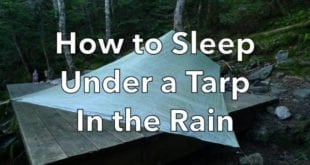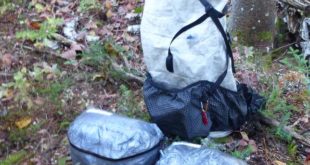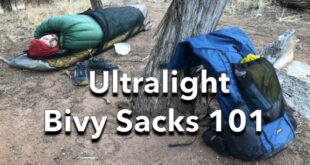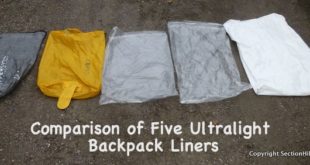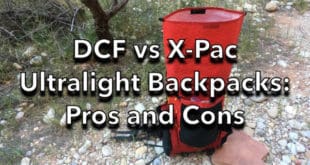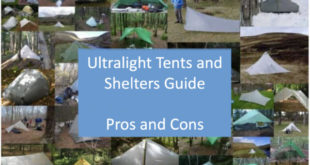Tarps are a great ultralight backpacking shelter option, provided they’re used in a climate where there’s no rain or occasional rain. To clarify, I’m talking about square or rectangular tarps with or without catenary cut ridgelines and sides, and not single wall …
Read More »Ultralight Backpacking
Hyperlite Mountain Gear WayPoint 35 Backpack Review
The Hyperlite Mountain Gear Waypoint 35 is a Dyneema DCF daypack designed for rugged adventure hiking, peak bagging, and backpacking with very low-volume ultralight loads. The Waypoint is a classically designed roll-top backpack with a stretch mesh front pocket, side water bottle …
Read More »Lightweight Backpacking Double Wall Tent Guide
Lightweight double-wall backpacking tents are making a comeback amongst ultralight backpackers with gear weights that rival their single-walled competitors. Double-wall tents have many advantages over single-walled tents, including: Less internal condensation Less drafty because they don’t have to be wind tunnels to …
Read More »Ultralight Backpacking Tent Footprints
Most tent footprints are unnecessarily heavy. But there are some easy ways to reduce the weight of your footprint using ultralight footprint alternatives. Backpackers and campers use tent footprints to protect the bottom of their tents from sharp rocks and sand that can …
Read More »Hyperlite Mountain Gear Packing Pods Review
Hyperlite Mountain Gear’s small and large packing pods are the ultralight equivalent of the luggage packing cubes that people use to pack travel bags. They’re U-shaped to fit snugly into Hyperlite’s backpacks and can be used in place of a white plastic compactor …
Read More »Flat Tarps vs Catenary Cut Tarps
The lightest weight ultralight backpacking shelters are tarps, including flat tarps and catenary curve tarps, sometimes called “flat cut” or “cat cut” tarps for short. They both have their pros and cons as we discuss below, but if your goal is wilderness …
Read More »The Joy of Esbit
Esbit Cubes are the simplest, lightest, and most reliable way to boil water or cook food on backpacking trips. There’s no extra container weight to carry with Esbit Cubes, like a white gas stove bottle or isobutane canister, and you can even …
Read More »Ultralight Bivy Sacks 101
Ultralight bivy sacks are used by backpackers for cowboy camping or under floorless shelters, such as tarps or pyramids, to protect their sleeping bags/quilts and sleeping pads from wind, insects, mice, and other creepy crawlers. Most are not waterproof and function more …
Read More »Best Dimensions for a 1 Person Backpacking Tarp
If you crave a deep connection with the wilderness, there’s nothing more intimate than sleeping under a square or rectangular tarp. Pitching a tarp takes more thought than setting up a tent because you need to consider what the best setup or “shape” will …
Read More »Comparison of Five Ultralight Backpack Liners
Backpackers are split about 50/50 when it comes to using a backpack rain cover or lining the inside of their backpacks with a plastic bag or backpack liner designed for that purpose. When I started backpacking, I used a backpack rain cover …
Read More »How to Reduce the Weight of Your Consumables
The heaviest items in your backpack are water, food, and fuel. They’re called consumables because you use them up as your trip progresses, as opposed to “base weight” which measures the weight of non-consumable items like a backpack, tent, unworn clothing, a …
Read More »DCF vs X-Pac for Ultralight Backpacks: Pros and Cons
Many waterproof and more durable ultralight backpacks are made with Dyneema Composite Fabric (DCF) or X-Pac, another high-tech laminate fabric similar to DCF but less expensive and easier to make backpacks with. Below, we explain the tradeoffs between these DCF and X-Pac …
Read More »Ultralight Backpacking Bug Shelter Primer
There are four different types of ultralight bug shelters suitable for cowboy camping, sleeping in a lean-to, or underneath a flat tarp: Bivy Sacks Bug Bivies Net Tents Floorless Tarps w/ no-see-um Skirts While they’re all similar in certain respects, they have …
Read More »Ultralight Tents and Shelter Guide: Pros and Cons
Ultralight backpacking tents and shelters come in all shapes and sizes, but each type has pros and cons for different camping conditions. It’s best to understand these before you waste money on a tent or shelter that doesn’t suit your needs or …
Read More » SectionHiker.com Backpacking Gear Reviews and FAQs
SectionHiker.com Backpacking Gear Reviews and FAQs 